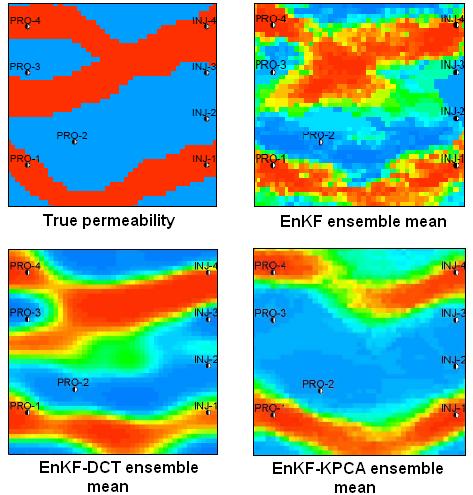In this reseach project, we investigate the use of ensemble Kalman filter (EnKF) for production data assimilation with discrete cosine transform (DCT) and kernel principle component analysis (KPCA) parameterization for channelized reservoirs, where the prior geostatistical model is based on multi-point statistics.
In the discrete consine transform (DCT), any 2-D image (or reservoir property fields) can be represented by a linear combination of some known discrete cosine basis functions. For signal processing and image compression, only the coeficients corresponding to the low frequency basis function are stored. Similarly, for reservoir data assimilation, using EnKF, we update the DCT coeficients of low frequency basis functions. The rock property fields can be reconstructed using these coeficients. In the kernel PCA method, the random vector of the rock property fields are mapped to a higher dimensional feature space, where the higher order moments of the the random vector in the original space are hopefully preserved. The mapped random vector of the rock property fields is parameterized as a linear combination of some eigenvectors of the covariance matrix corresponding to the largest eigenvalues in the feature space. As the feature space is high dimensional, this mapping is done with a “kernel trick”, where the eigenvectors of the covariance matrix are obtained from a kernel matrix. The kernel matrix involves only inner products of realizations of the random vectors of the rock property fields.
Although we believe both parameterization methods are promising for channelized reservoirs, our experiments with a 2D channelized reservoir shows limited improvements in permeability estimation and data prediction using EnKF. However, for a simple one parameter non-Gaussian problem, the KPCA implementation with EnKF could produce an accurate sampling of a posterior pdf with two distinct modes, while the standard EnKF failed to do so.

Example of mean permeability fields obtained after data assimilation with standard EnKF and EnKF with DCT and KPCA parameterization. The true permeability field and the initial ensemble were generated using multipoint geostatistics.